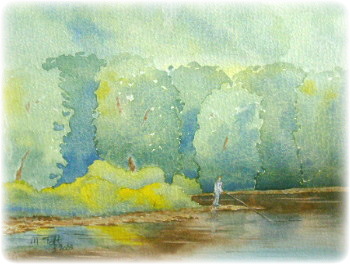Watercolour painting tutorial
Watercolor tutorial ~ Wash techniques
Now that you have seen the watercolour wash basics, I thought that I would explain a little more about washes by using the painting below as an example. This painting is dear to my heart as it is one of my favourite places in Cumbria.

In general, washes are used to cover large areas of a painting and washes ensure a even distribution of colour. The sky was painted with an intial wash of weak ultramarine blue and when it was completely dry another wash was added. This time a touch of pale red was added to ultramarine, giving the sky a purply tinge in addition to weak pale red towards the bottom of the sky. Once the sky was dry, a varigated wash was applied to the tree line in the distance; a weak green for the top-left of the tree line and the same pale red - ultramarine mix for the bottom of these trees and the trees in the far distance.
Painting Fir Trees. In essence, any area that is painted could be classified as a wash. The fir trees in the left foreground are a good example. I wanted to create distinction between the indiviual trees and as the real trees were really close together, the only way was to use tonal contrast. A base green was mixed and from this a darker green was created by adding Payne's Grey. I rotated the watercolour paper though ninety degrees so that the sky was to my left and started with the far left tree as you see it now. The base green wash was laid with the darker green being added using the wet-in-wet technique, thus allowing the two colours to merge. You will see that the tree is darker to the left and at the base. Once the tree was dry this was repeated for the other trees, using various tones of the base green to ensure distinction between trees and credibility of the painting.

This technique was also used for the Fly Fishing painting on the right. A varigated wash of a number of pale greens was used for the top of the painting. Then the front, lighter trees were washed with darker tones used for the lower areas and a splash of yellow (wet-in-wet) at the top to create the odd splash of sunlight. Once dry, the darker trees at the back were added, ensuring darker tones for the shadows toward the bottom of the trees. The bushes on the far bank used the wet-in-wet technique with yellow being the first colour and a variety of greens being added lower down.
Watercolour Paintings Landscapes Minimal Landscapes Wildlife Nudes Beaches and Boats Abstract Commissions Watercolour Gallery
Latest Work
Cockington Collection Lanercost CollectionWatercolor Tutorials
Equipment Colour and Tone Watercolour Washes Wash Techniques Perspective How to Paint Trees Watercolor Tutorial 1 Watercolor Tutorial 2 Watercolor Tutorial 3 Watercolor Tutorial 4Guest Artists
James Baldwin Lucy Toft Hamish CormackCOPYRIGHT All images shown on this website are protected by copyright. No artwork may be reproduced without prior consent by the artists.
Art Links
If you have an art related website and would like to exchange links, please click here.
Art and Design
Web design by zero78


Thank you for reading about watercolour equipment. Please now proceed to the next part of this watercolor painting tutorial.